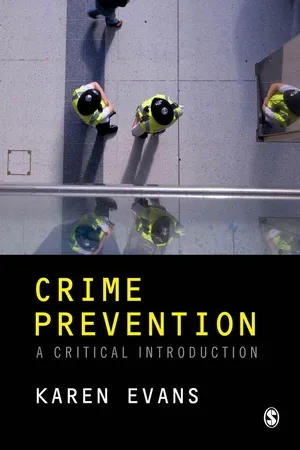Law
Prevention of crime
Prevention of crime refers to the strategies and measures aimed at reducing the occurrence of criminal activities within a society. This can include initiatives such as community policing, public education, and social programs designed to address underlying causes of criminal behavior. The goal of crime prevention is to create safer communities and reduce the need for law enforcement intervention.
Written by Perlego with AI-assistance
Related key terms
8 Key excerpts on "Prevention of crime"
- eBook - ePub
- Russil Durrant(Author)
- 2018(Publication Date)
- Routledge(Publisher)
There is no widespread agreement within criminology concerning the precise nature and scope of the term ‘crime prevention’ (Sutton, Cherney, & White, 2014). One of the most inclusive definitions is provided by Brantingham & Faust (1976, p. 284) who view crime prevention as ‘any activity, by an individual or a group, public or private, that precludes the incidence of one or more criminal acts’. This definition, therefore, includes any activity on the part of the criminal justice system (such as punishment or policing) that might result in a reduction in criminal behaviour. Other scholars prefer an approach to defining crime prevention that excludes the activities of the criminal justice system and focuses, instead, on other kinds of activities and initiatives (Sutton et al., 2014). To confuse matters somewhat, other terms such as ‘crime reduction ’, ‘public safety’, and ‘community safety’ are also widely employed in similar contexts (Tilley, 2009). In this chapter we will employed the term ‘crime prevention’ to refer to all activities and initiatives (excluding the actions of the criminal justice system) that attempt to prevent (or, at least, reduce) criminal and antisocial behaviour.Crime prevention typologies
Two main typologies are widely employed in the crime prevention literature (see Figure 11.1 ). The first makes a distinction – adapted from public health initiatives – between primary, secondary, and tertiary crime prevention approaches (Brantingham & Faust, 1976; Lab, 2016). Primary crime prevention refers to approaches that are largely directed at the general population and includes such diverse strategies as improved street lighting and universal drug-education programmes in schools. Secondary crime prevention involves the development of programmes and initiatives that are targeted as specific ‘at risk’ groups or locations such as delinquent teenagers or high-crime neighbourhoods. Attempts to reduce crime that focus on offenders (e.g., rehabilitation programmes) are viewed as instances of tertiary crime prevention - eBook - ePub
Criminal Justice
An Introduction
- Peter Joyce, Wendy Laverick(Authors)
- 2022(Publication Date)
- Routledge(Publisher)
A statement as to what we mean by the term crime prevention is provided in a statement issued currently available on the website of the New York State Police. This defines crime prevention as:- the anticipation, recognition, and appraisal of a crime risk, and the initiation of action to remove or reduce it;
- an active approach utilising public awareness and preventive measures to reduce crime;
- reflecting a philosophy of self-defence where the police and the community take action before crimes are committed.
- Crime Prevention programmes will reduce crime, stimulate public awareness concerning crime prevention and enhance our communities.
- Crime prevention works. It is cheaper, safer, and healthier for communities to prevent crime than to have to treat its victims, deal with its perpetrators and lose civic health and productivity.
- But the responsibility of crime prevention doesn’t fall on one person – it’s everyone’s business. Law enforcement agencies, however, often are the focal point in community crime prevention (New York State Police, 2020: [Online]).
This statement makes it clear that the task of stopping a crime from occurring involves a very wide range of actions and although the police have a role in carrying these out, other agencies and ordinary members of the general public can also make a significant contribution to this task.The academic context – ‘nothing works’
A major critique of existing attempts to alter the offending habits of convicted offenders derived from America where a review of 231 studies of American prison rehabilitation programmes conducted between 1945 and 1976 (subsequently published by Lipton et al., 1975 ) was reported by Robert Martinson who concluded that ‘with few and isolated exceptions, the rehabilitative efforts that have been reported so far have had no appreciable effect on recidivism . . . our present strategies . . . cannot overcome, or even appreciably reduce, the powerful tendencies of offenders to continue in criminal behaviour’ (Martinson, 1974 - eBook - ePub
- Sandra Walklate(Author)
- 2016(Publication Date)
- Routledge(Publisher)
In this chapter we shall consider the key trends in crime prevention that have occurred over the last 30 years and we shall explore their links with different strands of criminological thought. More importantly, however, this chapter will be just as concerned with demonstrating what has been made visible and invisible within these trends. In other words, the reader will be asked to think about what kinds of crimes policy trends have paid attention to and why. However, first of all, it is important to say something about what is assumed by the idea of crime prevention.WHAT DOES PREVENTION MEAN?
In general terms, ‘prevention’ is taken to be a ‘good thing’. Whether with respect to health, poverty, or crime, prevention is assumed to be a good thing because social problems are seen to be bad things. However, in any context, understanding prevention involves two connected processes; being able to predict the outcome of a chain of events, and then being able to devise a way of intervening with, or altering that predicted outcome. Within criminology crime prevention implies that we can identify the cause of crime and on the basis of this devise policies that can stop crime from happening. (For those of you who have managed to make it this far through this book, you should already be aware of what a tall order this is!) The ever changing nature of crime, and the ways in which it is committed, indicate how complicated a relationship this may be. Nevertheless, policy makers and politicians, sometimes informed by criminologists sometimes not, spend a good deal of time being preoccupied with crime prevention. In recent years, however, it has become more popular to talk of crime reduction and/or community safety, or even the notion of resilient communities. This change in terminology sends out the message that the possibility of preventing crime is less likely than reducing it or managing it better as a social problem, in order to make people feel better about crime. The reader will undoubtedly make up his or her own mind on whether this is likely to be the case.As this chapter unfolds it will become clear that there are different ways in which crime prevention is understood and subsequently acted upon. Ken Pease (2002), an internationally recognised criminologist who has frequently worked within the crime prevention area, argues that there are three broad approaches to the cause of crime. We have used his terms earlier in this book but to reiterate them here they are: psyche, opportunity and structure. These terms all articulate different ways of thinking about how to proceed with crime prevention (reduction). - eBook - ePub
Crime Prevention
Approaches, Practices, and Evaluations
- Steven P. Lab(Author)
- 2023(Publication Date)
- Routledge(Publisher)
situational crime prevention in 1983. Developed by the British Home Office, situational crime prevention refocused attention from broad social/community change to target-, time-, and place-specific efforts that would remove the opportunities for crime. This move took crime prevention from the macro-level to the micro-level of interest.Summary
This short presentation demonstrates that crime prevention is an idea that has been around for as long as there has been crime. Although the form has changed and the term crime prevention is relatively new, the concern over safety is ages old. Throughout most of history, it was the individual’s responsibility, either voluntarily or through obligation, to deal with crime and offenders. In the nineteenth and twentieth centuries, society moved to a system of police, courts, and corrections, which assumed the primary responsibility for crime.Since the 1960s there has been a growing movement toward bringing the citizenry back as active participants in crime prevention. Although many see this type of community action as “new,” in reality it is more a movement back to age-old traditions of individual responsibility than it is a revolutionary step forward in crime control. Crime prevention must utilize the wide range of ideas and abilities found throughout society. Community planning, architecture, neighborhood action, juvenile advocacy, security planning, education, and technical training, among many other system and nonsystem activities, all have a potential impact on the levels of crime and fear of crime. The realm of crime prevention is vast and open for expansion.Defining Crime Prevention
The definition of crime prevention varies from study to study and program to program. Ekblom (2005 , p. 28) states, “Crime prevention is intervention in the causes of criminal and disorderly events to reduce the risks of their occurrence and/or the potential seriousness of their consequences.” This definition addresses both crime and its impact on individuals and society. As outlined in the last chapter, the consequences of crime are not inconsequential. While most definitions of crime prevention - eBook - ePub
Crime Prevention
Theory, Policy And Practice
- Daniel Gilling(Author)
- 2005(Publication Date)
- Routledge(Publisher)
Consequently, the modern use of the term to refer to contemporary developments in crime control, sometimes complementary and some times in opposition to more traditional institutional responses (police, probation and prisons), is in fact somewhat misleading, and fails to capture the essence of the changes currently taking place in crime control policies both in England and Wales, and across much of the world. Crime prevention, then, is too vague and broad a term on which to hang a study such as this, and requires further elaboration, for as it stands it has a catch-all nature that defies disciplining, enabling it to embrace a range of areas that would by themselves be worthy of study in their own right. Crime prevention incorporates not only the practices of the entire criminal justice system, but also those of many other social and public policies, as well as those of private citizens and private enterprise. The situation is further complicated when one considers that the Prevention of crime is often not the primary rationale for practices that do, nevertheless, have a crime preventive effect.If we were to unpack the concept of crime prevention, we would immediately recognize that crime itself is by no means a precise term, covering a host of qualitatively and quantitatively different acts that, as befits social constructs, vary across time and space. But the real problem lies with the word prevention, which Billis (1981:368) succinctly and accurately describes as “slippery”, and certainly difficult to contain. Freeman (1992) explores the reasons for this by breaking the word down into two constituent parts, namely prediction and intervention. That is to say that in order to prevent the occurrence of something one must first be able to predict where it is likely to occur, and then apply appropriate intervention at this predicted point. Prediction is, however, literally a risky business. It depends upon a theory of causality, and when applied to social constructs such as crime and criminality it is very uncertain, drawing as it does upon social scientific knowledge and understanding that has historically proved to be “more successful at predicting the experience of populations than of individuals.” (Freeman 1992:36). Social science, as Graham (1990:11) observes, “is not an exact science. It deals largely with probabilities and correlates rather than certainties and causes.” - eBook - ePub
Psychology and Crime
2nd edition
- Aidan Sammons, David Putwain(Authors)
- 2018(Publication Date)
- Routledge(Publisher)
10Crime prevention
The goal of crime prevention is to reduce the amount of criminal activity and the harm that it causes along with the number of criminal offenders and their victims. Crime prevention strategies are used by individuals, communities, businesses and government to target those factors that are known to cause crime in order to facilitate a reduction in crime. This chapter surveys some of the ways in which psychology can contribute to reducing crime. It starts by distinguishing between different types of crime prevention and then discusses how crime can be prevented by altering the environment, intervening with people at risk of involvement in criminal activity and by helping to rehabilitate offenders.Approaches to crime prevention
The Public Health Model is an approach to crime prevention adopted from the medical profession. The medical approach to, for example, heart disease is not solely based on emergency procedures that occur once someone has already had a heart attack, but on ways in which people can reduce their risk of developing heart disease in the first place (e.g. adopting a healthy lifestyle). In the Public Health Model of crime prevention there are three interrelated and coordinated approaches for reducing the seriousness and incidence of criminal behaviour: primary, secondary and tertiary (Mackey, 2012). Primary and secondary preventions are forms of deterrence; they try to encourage people not to commit an offence. Tertiary prevention aims to reform offenders so that they do not reoffend (see Chapter 9 ).Primary crime prevention refers to proactive attempts to prevent crime before it happens. These include strengthening resiliency factors that help individuals to avoid criminal behaviours, and reducing risk factors that increase the likelihood of criminal behaviour. Such programmes could include those in schools designed to reduce risk factors in children and adolescents that might lead to more serious criminal activity later in life such as drug and alcohol use, carrying a knife and joining a gang (Regoli et al., 2010). - eBook - ePub
Community Policing
A Contemporary Perspective
- Victor E. Kappeler, Larry K. Gaines, Brian P. Schaefer(Authors)
- 2020(Publication Date)
- Routledge(Publisher)
The first is social development programs that attempt to negate the factors that influence juveniles and adults to engage in criminal behavior. In the long term, social development programs have the most potential to reduce crime compared to any other type of crime prevention. If we can keep youths from entering a life of crime and drug abuse, we will have a more drastic impact on crime. Unfortunately, political leaders have not invested in these types of programs. The second crime prevention strategy is situational crime prevention. Situational crime prevention attempts to make crime more difficult through environmental design and enhanced surveillance. It involves making crime more difficult and increasing the risk to potential criminals. In essence, situational crime prevention attempts to deter criminals. The third strategy is community crime prevention programming. The essence of community crime prevention is community involvement. The police have long understood that efforts to combat crime can be successful only when people are actively involved in assisting the police. Examples of these programs include neighborhood or block watches, citizen patrols, the identification of property, and media campaigns. The fourth category of crime prevention strategy is legislative/administrative strategies. Programs within this strategy include efforts to pass statutes and administrative regulations that prevent crime or enhance law enforcement’s ability to tackle a particular crime problem. Over the years, there have been a number of legislative changes relating to domestic violence, gangs, driving while under the influence, and municipal code enforcement that have provided law enforcement with new tools to counter a particular crime or disorder problem. Finally, police programs include traditional police responses to crime. Community policing departments must maintain some level of traditional methods of combating crime. However, when these methods are coupled with community policing and crime prevention activities, the police generally experience more success.The advent of community policing has resulted in numerous changes in law enforcement. One important change has been an increased awareness of how crime prevention can have an impact on a number of traditional police problems. When implementing crime prevention, it is important for the police to “think outside the box.” Police officers should use the SARA model of problem identification and strategy selection and consider as many alternatives as possible. Success comes through innovative thinking. Past practices have not always been the best practices. Crime and disorder should be approached from a number of directions. - eBook - ePub
Crime Prevention
A Critical Introduction
- Karen Evans(Author)
- 2010(Publication Date)
- SAGE Publications Ltd(Publisher)
Despite criticisms of the situational crime prevention which have labelled it as fundamentally pessimistic and, as Wilson acknowledges, concerned only with ‘moderate gains’ rather than ‘utopian goals’, situational crime prevention is seen as a practical, immediate and relatively low-cost solution to crime with measurable outcomes. This is contrasted to social crime prevention measures which are considered expensive to maintain over the long-term and indeterminate in their results. Crawford has argued, however, that the inexorable rise of situational crime prevention is more related to a political perspective which emphasises individual responsibility for both the commission of crime and its prevention and which rejects any measures based on collective and social responses. He argues that:The installation of governments committed to a neo-liberal ideology – emphasising the free market, a minimal state and individual free choice and responsibility – dovetailed with and promoted criminological ideas which shared the same basic propositions. As a consequence, the spread of situational crime prevention needs to be understood as connected to the political programmes with which it is aligned. (Crawford 1998: 65)Social crime prevention
In contrast to situational crime prevention measures social crime prevention considers the causes of criminality to be rooted within social formations and intervenes in the social world of the individual to attempt to divert them from offending. Social crime prevention is mainly concerned with strengthening the social bonds which tie individuals to normative groups and values with the expectation that this will make offending against these groups less likely and will equip the individual with a moral code which will steer them towards more positive goals and aspirations. It does not identify the causes of criminality within the individual’s pathology but looks at how social structures can influence rates of crime. Social crime prevention is therefore more aligned to social policy interventions in schools, housing, employment and services to children, young people and families.The first identification of social structure as contributing to the problem of crime came with the work of the Chicago School of sociologists in the early twentieth century. They identified the newly emerging urban landscapes of America with socially disorganised neighbourhoods, weak social ties and an absence of shared values, norms and expectations as key to understanding the high rates of offending found within them. Building neighbourhood projects, family support and youth schemes were perceived as important factors in reducing people’s propensity to commit crime. Social crime prevention was later linked to Hirschi’s control theory, which explained why people conform to social expectations, Merton’s strain theory, which pointed to the disjuncture between legitimate aspirations and the lack of opportunities available to residents of disadvantaged neighbourhoods as a key motivational factor behind their offending, and to the work of Cloward and Ohlin on the ways in which young people adapt to their limiting social environments (Crawford 1998: 104–7).
Learn about this page
Index pages curate the most relevant extracts from our library of academic textbooks. They’ve been created using an in-house natural language model (NLM), each adding context and meaning to key research topics.







